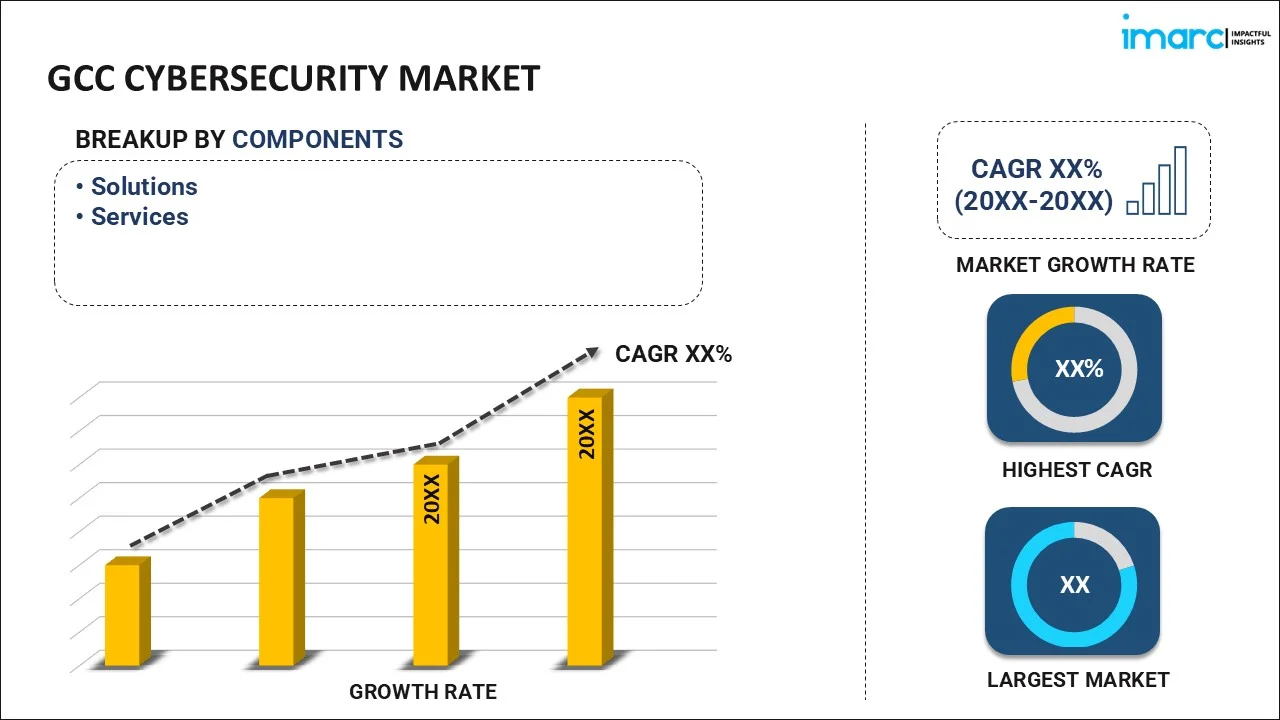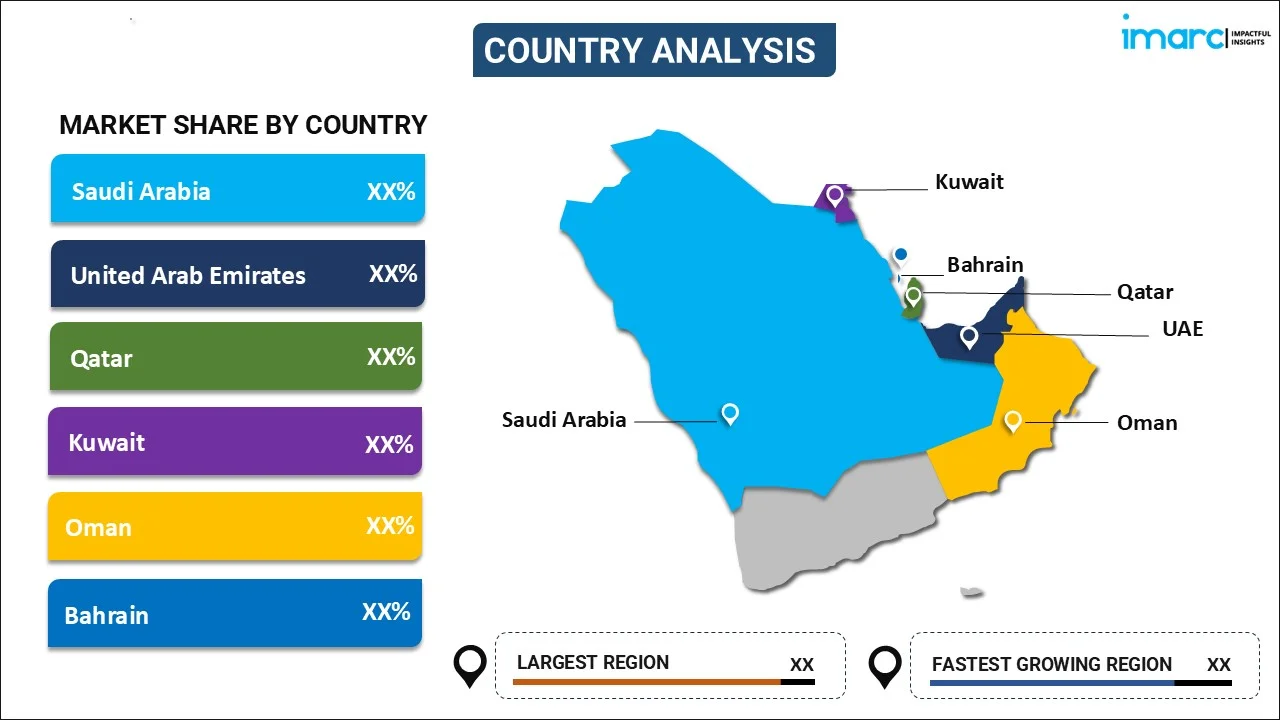
GCC Cybersecurity Market Report by Component (Solutions, Services), Deployment Types (Cloud Based, On-Premises), User Type (Large Enterprises, Small and Medium Enterprises), Industry Vertical (IT and Telecom, Retail, BFSI, Healthcare, Defense/Government, Manufacturing, Energy, and Others), and Country 2025-2033
Market Overview:
The GCC cybersecurity market size reached USD 5.7 Billion in 2024. Looking forward, IMARC Group expects the market to reach USD 9.0 Billion by 2033, exhibiting a growth rate (CAGR) of 5.1% during 2025-2033. The increasing cyber threats, ongoing digital transformation, strict data protection and privacy regulations, technological advancements, and the increasing remote workforce represent some of the key factors driving the market.
|
Report Attribute
|
Key Statistics
|
|---|---|
|
Base Year
|
2024 |
|
Forecast Years
|
2025-2033
|
|
Historical Years
|
2019-2024
|
| Market Size in 2024 | USD 5.7 Billion |
| Market Forecast in 2033 | USD 9.0 Billion |
| Market Growth Rate (2025-2033) | 5.1% |
Cybersecurity is vital in safeguarding computer systems, networks, software, and data from various digital threats, ensuring confidentiality, integrity, and availability. Its overarching goal is to defend against unauthorized access, cybercrime, hacking, malware, data breaches, ransomware, phishing, and other malicious activities. It employs a combination of proactive and reactive approaches, encompassing a wide range of measures and strategies. It involves implementing preventive measures like firewalls, encryption, access controls, and comprehensive security awareness training for users. These measures help fortify the digital infrastructure and minimize vulnerabilities. The rapid proliferation of the Internet of Things (IoT), cloud computing, and mobile devices has significantly increased the attack surface, intensifying the need for continuous and adaptable cybersecurity practices. To maintain the trust and stability of digital assets, emphasizing a robust cybersecurity posture is paramount. By actively defending against cyber threats and diligently responding to incidents, organizations can foster a safe and secure digital environment for their users and protect their valuable information and resources.
GCC Cybersecurity Market Trends:
The increasing demand for cybersecurity due to the growing cyberattacks targeting businesses and governments as the GCC economies become more digitally connected is one of the major factors driving the market growth. In line with this, the growing adoption of cybersecurity owing to the frequency and complexity of these attacks prompting organizations to invest significantly in advanced cybersecurity tools and services to fortify their defense mechanisms, is strengthening the market growth. In confluence with this, the growing integration of cloud computing, IoT, and mobile technologies into the operations of various companies, increasing the need for adaptive and proactive cybersecurity solutions that can detect and respond to emerging threats in real-time, is positively impacting the market growth in the region. In addition to this, the advent of government regulations and compliance standards imposing strict data protection measures and mandating organizations to implement robust cybersecurity frameworks are providing a considerable boost to the market growth. Moreover, the expansion of remote work arrangements exposing businesses to new cybersecurity challenges with employees accessing company networks and sensitive data from remote locations, increasing the potential for security breaches, is creating a positive outlook for the market growth. Besides this, the increasing demand for managed security services in small and medium-sized enterprises (SMEs) and larger organizations to outsource their security operations is favoring the market growth. Apart from this, the rising adoption of emerging technologies, such as artificial intelligence (AI) and machine learning (ML), revolutionizing the cybersecurity landscape in the GCC, empowering cybersecurity solutions to analyze vast amounts of data and identify patterns indicative of potential threats, is providing remunerative growth opportunities.
GCC Cybersecurity Market Segmentation:
IMARC Group provides an analysis of the key trends in each segment of the GCC cybersecurity market report, along with forecasts at the regional and country levels for 2025-2033. Our report has categorized the market based on component, deployment type, user type, and industry vertical.
Component Insights:

- Solutions
- Identity and Access Management (IAM)
- Infrastructure Security
- Governance, Risk and Compliance
- Unified Vulnerability Management Service Offering
- Data Security and Privacy Service Offering
- Others
- Services
- Professional Services
- Managed Services
The report has provided a detailed breakup and analysis of the market based on the component. This includes solutions (identity and access management (IAM), infrastructure security, governance, risk and compliance, unified vulnerability management service offering, data security and privacy service offering, and others) and services (professional services and managed services).
Deployment Type Insights:
- Cloud Based
- On-Premises
A detailed breakup and analysis of the market based on the deployment type has also been provided in the report. This includes cloud based and on-premises.
User Type Insights:
- Large Enterprises
- Small and Medium Enterprises
A detailed breakup and analysis of the market based on the user type has also been provided in the report. This includes large enterprises, and small and medium enterprises.
Industry Vertical Insights:
- IT and Telecom
- Retail
- BFSI
- Healthcare
- Defense/Government
- Manufacturing
- Energy
- Others
A detailed breakup and analysis of the market based on the industry vertical has also been provided in the report. This includes IT and telecom, retail, BFSI, healthcare, defense/government, manufacturing, energy, and others.
Country Insights:

- Saudi Arabia
- UAE
- Qatar
- Bahrain
- Kuwait
- Oman
The report has also provided a comprehensive analysis of all the major regional markets, which include Saudi Arabia, the UAE, Qatar, Bahrain, Kuwait, and Oman.
Competitive Landscape:
The report has also provided a comprehensive analysis of the competitive landscape in the market. Competitive analysis such as market structure, key player positioning, top winning strategies, competitive dashboard, and company evaluation quadrant has been covered in the report. Also, detailed profiles of all major companies have been provided.
GCC Cybersecurity Market Report Coverage:
| Report Features | Details |
|---|---|
| Base Year of the Analysis | 2024 |
| Historical Period | 2019-2024 |
| Forecast Period | 2025-2033 |
| Units | Billion USD |
| Scope of the Report | Exploration of Historical and Forecast Trends, Industry Catalysts and Challenges, Segment-Wise Historical and Predictive Market Assessment:
|
| Components Covered |
|
| Deployment Types Covered | Cloud Based, On-Premises |
| User Types Covered | Large Enterprises, Small and Medium Enterprises |
| Industry Verticals Covered | IT and Telecom, Retail, BFSI, Healthcare, Defense/Government, Manufacturing, Energy, Others |
| Countries Covered | Saudi Arabia, UAE, Qatar, Bahrain, Kuwait, Oman |
| Customization Scope | 10% Free Customization |
| Post-Sale Analyst Support | 10-12 Weeks |
| Delivery Format | PDF and Excel through Email (We can also provide the editable version of the report in PPT/Word format on special request) |
Key Questions Answered in This Report:
- How has the GCC cybersecurity market performed so far and how will it perform in the coming years?
- What has been the impact of COVID-19 on the GCC cybersecurity market?
- What is the breakup of the GCC cybersecurity market on the basis of component?
- What is the breakup of the GCC cybersecurity market on the basis of deployment type?
- What is the breakup of the GCC cybersecurity market on the basis of user type?
- What is the breakup of the GCC cybersecurity market on the basis of industry vertical?
- What are the various stages in the value chain of the GCC cybersecurity market?
- What are the key driving factors and challenges in the GCC cybersecurity market?
- What is the structure of the GCC cybersecurity market and who are the key players?
- What is the degree of competition in the GCC cybersecurity market?
Key Benefits for Stakeholders:
- IMARC’s report offers a comprehensive quantitative analysis of various market segments, historical and current market trends, market forecasts, and dynamics of the GCC cybersecurity market from 2019-2033.
- The research study provides the latest information on the market drivers, challenges, and opportunities in the GCC cybersecurity market.
- Porter's five forces analysis assist stakeholders in assessing the impact of new entrants, competitive rivalry, supplier power, buyer power, and the threat of substitution. It helps stakeholders to analyze the level of competition within the GCC cybersecurity industry and its attractiveness.
- Competitive landscape allows stakeholders to understand their competitive environment and provides an insight into the current positions of key players in the market.
Need more help?
- Speak to our experienced analysts for insights on the current market scenarios.
- Include additional segments and countries to customize the report as per your requirement.
- Gain an unparalleled competitive advantage in your domain by understanding how to utilize the report and positively impacting your operations and revenue.
- For further assistance, please connect with our analysts.
 Inquire Before Buying
Inquire Before Buying
 Speak to an Analyst
Speak to an Analyst
 Request Brochure
Request Brochure
 Request Customization
Request Customization




.webp)




.webp)












